|
FAQs on Identification of Stinging-Celled
Animals
21
Related Articles: Cnidarians, Water Flow, How Much
is Enough,
Related FAQs: Cnidarian IDs 1, Cnidarian IDs 2, Cnidarian IDs 3, Cnidarians ID 4, Cnidarians ID 5, Cnidarians ID 6, Cnidarian ID 7, Cnidarian ID 8, Cnidarian ID 9, Cnidarian ID 10, Cnidarian ID 11, Cnidarian ID 12, Cnidarian ID 13, Cnidarian ID
14, Cnidarian ID
15, Cnidarian ID
16, Cnidarian ID 17, Cnidarian ID 18, Cnidarian ID 19, Cnidarian ID 20, Cnidarian ID 22, Cnidarian ID 23, Cnidarian ID 24, Cnidarian ID 26, Cnidarian ID 27, Cnidarian ID 28,
Cnidarian ID 28,
Cnidarian
ID 29,
Cnidarian ID 30,
Cnidarian ID 31,
& Anemone ID 1, Aiptasia
ID 1, Stony Coral ID
1, Mushroom Identification,
Soft Coral ID, Alcyoniid ID, Xeniid ID,
|
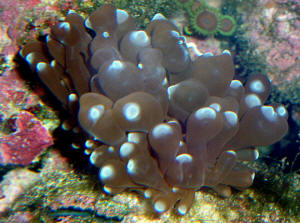
|
|
Possible SPS Hitchhiker/Coral ID 11/05/09
I bought a small rock with some yellow polyps on it and after a
week I noticed two encrusting colonies growing on it. I can't
seem to find out what these are. They are two different types of,
what I am hoping are corals, and even the colours are
different.
The diameter of the larger heads are about 1mm, and the smaller
ones, on the lower colony, are about .5mm in diameter.
I'm hoping to find out what they are so that I can place them
properly in the tank. I want to see what these guys will look
like when they continue to grow out. Since I don't know if
they are coral that
relies on photosynthesis or not I don't know if they will
need supplemental feedings.
A little on the tank: it's a 90G reef setup with a 30G sump
and a separate 10G refuge. I have about 110lbs of live rock and a
good sandbed. There are some other corals (mostly Zoas and LPS,
but one
Monti).
<What you have are Zoanthid colonies, commonly called Sea
Mats, Button Polyps or False Corals. See here.
http://www.wetwebmedia.com/zoanthid.htm>
Thanks in advance,
<You're welcome. James (Salty Dog)><<Good eye
James. B>>
Jason
|
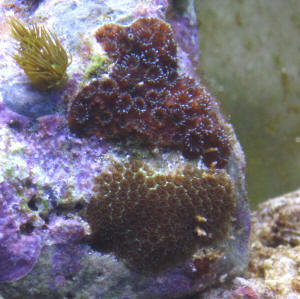 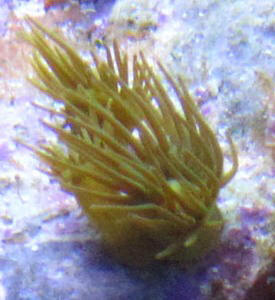 |
|
Re Possible SPS Hitchhiker/Coral ID
11/6/09
Thanks.
<You're welcome.>
I've never seen Zoas look like these.
<Many species.>
I've shown the picture to a local saltwater aquarium society
and no one mentioned Zoas. They mentioned that it could be a type
of encrusting Monti or possible Cyphastrea. Since there were no
actual stalks below the heads, no one
mentioned Zoas. The heads are attached directly to the mat.
<Likely why they are called Sea Mats. James (Salty
Dog)>
|
|
Unable to identify 10/17/09
We've been all over the site and net looking for these
critters. No luck.
We posted on the LR Hitch Hikers forum. Someone suggested we
contact the WWM crew to see if possibly they knew what it
was.
Please find attached pics. They're pinkish in color, have
branchlike tentacles some with tiny green balls at the end. Their
bases expand with either air or water, they inflate and then move
to another location of their choice. When they move, they seem to
roll.
They also appear to have the ability to sting as one of our fish
inadvertently touched one and didn't like it one bit.
Specs:
25 gallon salt water
temp 79
20 lbs LR
PH 8.0
Ammonia 0
Nitrite 0
Nitrate 0
Phos 0.5
Salinity 1.025
2 mollies, 1 cleaner shrimp, zooanthids, button polyps, star
polyps, green elephant ear mushrooms, strawberry anemone, cabbage
leather, some snails and numerous brittle starfish
fluval biological 150, separate aeration, 15 watt 18" 50/50
fluorescent bulb
Thanks!
<... the object in the middle of your photo? This is some sort
of Alcyonacean... a soft coral... A Nephtheid... but can't
make out much more from this pic. Please send along one of higher
resolution for a better,
more defined guess. Bob Fenner>
|
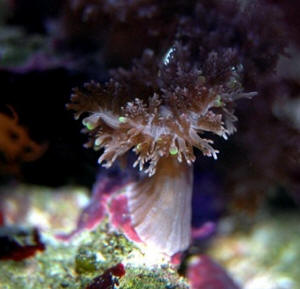 |
|
Re: unable to identify 01/18/09
Hi Bob,
Here are some clearer pics.
We've included as many different angles as we could get....
hoping to find something distinctive to aid in
identification.
Mitch and Melissa
<Am thinking more and more that this may be a juvenile colony
of Capnella sp. BobF>
<And these other pix... Some sort of arborose sea anemones.
BobF>
|
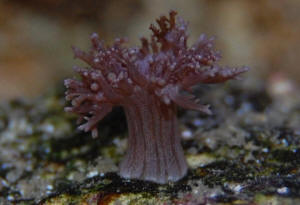 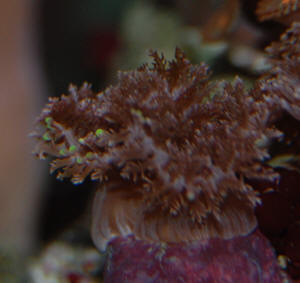 |
|
Hitchhiker ID 10/14/09
Hello Crew,
I've found a couple strange organisms in my tank recently I
would like some help identifying. The first came attached to the
tube of a trumpet coral. I cleaned it before I put it into the
tank, but this didn't wipe off and looked like coralline
algae. Over the past couple weeks it has filled out and opens up,
sometimes in the day sometimes at night, showing the tentacles
that encircle it. It seems like an interesting organism though
attached in a bad spot.
<Good desc.. Does appear Polypoid... colonial, lacking a hard
skeleton...
The arrangement of tentacles... My guess is on this being some
sort of Zoanthid... You may want to try removing it... as it will
too likely grow, outcompete your Trumpet. Do see WWM re Zo
compatibility... as there are some important cautionary remarks
re doing this scrubbing outside the display tank, with gloves,
eye-protection... should you go the removal route>
The second is living in a piece of live rock that has been in the
tank for 4 months. It looks to have taken up residence on one
hole and has not moved in the last week. It is a blue worm
looking thing.
<Indeed>
What I found strange is the pile of 'shavings' that has
accumulated beneath this organism's home. I have blown the
pile away twice now and it has collected again. The sum of these
'shavings' is much larger than what I have seen of this
animal. I can't tell if it is waste, or if it is tunneling in
the live rock. Any help would be very much appreciated.
Thanks,
Adam
<Appears to be a "segmented worm" of bluish
colour... could be a member of a few phyla... Need a "head
shot" of good resolution to guess further.
Please read here: http://wetwebmedia.com/HighInvertInd.htm
the second tray down. Bob Fenner>
|
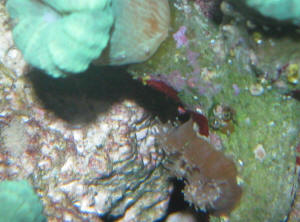 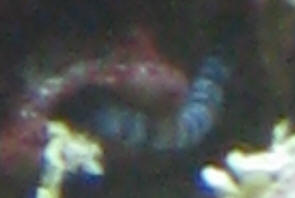 |
|
coral id please 10/3/09
[IMG]http://i730.photobucket.com/albums/ww304/stoner2123/100_3611.jpg[/IMG]
got this as a hitchhiker and cant fine it anywhere thanks and it
is soft to the touch
<?... this image is too small for any real ID... From the
gross aspect it looks to be a Faviid though, not an Alcyonacean.
Bob Fenner>
|
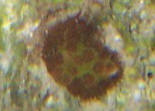
re: coral id please --
10/3/09
thanks but i was looking at it again last night and it is not a
soft coral it is a hard coral sorry
<Ahh... see my last resp. BobF>
|
|
Query Regarding Strange Specimen -
10/01/2009
Dear WetWebMedia,
<Dear Writer! Crewmember Sabrina with you today.>
I have been browsing Wet Web Media for some time, and find it to
be wonderful and informative.
<Thank you very much for these kind words.>
Unfortunately, I have been unable to find any information
regarding a creature I found in my 10-gallon nano tank. This tank
has about twelve pounds of live rock, and a red crab who
hitchhiked in on a rock. Among other inhabitants, it has had a
bizarre netted flatworm, a bright green mantis shrimp, and
several other strange, but interesting, animals. I have managed
to locate information on these other creatures, but not this
anemone. The specimen has just divided, leaving me two half-inch
anemones.
Considering that I first saw it at one half inch in diameter, I
thought it might perhaps grow larger before dividing as it did.
It has short tentacles that do not appear to sting, but adhere to
fingers when presented.
<The main knee-jerk reaction that I took this question is the
preceding statement. I feel compelled to mention that not all
critters in reef tanks are safe to touch! PLEASE be cautious
about poking about or intentionally touching cnidarians and other
reef life. For one, it's not very good for the Cnidarian. For
two.... Well, do a search on palytoxin and understand that there
are good reasons to be cautious about unknown - and even
well-known - animals in reef tanks. Blanket statement: wear
gloves when working in fish tanks. I'll be the first to admit
that I don't always do so myself in my own tanks, but I
should.>
It is fluorescent under actinic lighting.
I had fed the anemone mysis shrimp and other meaty goods before,
but the other day it got a hold of one of my young Bettas that
had escaped into the marine tank.
<Yee-ikes!>
The Betta was retrieved, but did not survive.
<I'm so sorry to hear this. It may have been the saltwater
more than the brush with the Cnidarian in question. Please
consider lids for any of those Betta tanks that don't have
one, eh?>
While I do not believe it is a Majano or Aiptasia,
<It is neither an Aiptasia, nor an Anemonia majano. Of that I
am certain.>
I could not say for certain. Finally, I note that I do not intend
on populating the tank with fish. I find it interesting to
discover new and interesting creatures almost weekly.
<Neat! I have to say, that can be more fun than a tank full of
fish.>
Attached Images:
Anemone 1: Creature shortly after I had found it.
Anemone 2: Creature about three months after discovery.
Anemone 3: Immediately after it divided.
Anemone 4: One day after it divided and relocated.
<I think.... and that is to say, I'm not sure.... this
might be a Stichodactyla tapetum, "mini carpet
anemone". My first thought was that it's a Ricordea of
some sort, and that may be the case, but the smooth center with
radiating lines seems more consistent with Stichodactyla tapetum.
Take a look at images of this and also of Ricordea. Hopefully Bob
will provide further input if I am completely in error.>
Thank you for your time, Sunstar
<Glad to be of service. Thanks for the very nicely taken
photos! Wishing you well, -Sabrina>
|
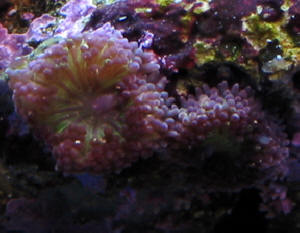 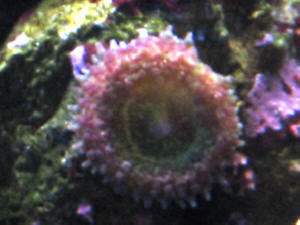 |
|
A couple of unknowns on live rock
9/20/09
Dear WetWeb,
I swear I have been through all the available hitchhiker sites I
could find and I can't seem to ID these 2 things.
The polyp (white thing in 1st picture) has been there awhile and
does not seem to get larger.
<This is almost assuredly an Actinarian/Anemone... Looks to be
a type of Aiptasiid, Glass... small likely due to a lack of
nutrient here:
http://wetwebmedia.com/marine/inverts/cnidaria/anthozoa/aiptasia/aiptasia.htm>
The green things may be some kind of alga (or two), but wanted
your opinion. There are also some single stranded things like the
larger green star like thing in various places.
Any ideas?
Thanks!
Roxanne
<And these... Stoloniferans... Polyps... Please see here:
http://wetwebmedia.com/clavulariids.htm
Bob Fenner>
|
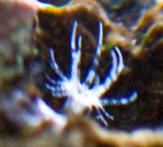 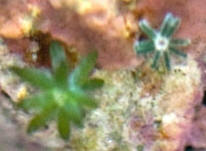 |
Re: a couple of unknowns on live rock
9/20/09
Thank you! This, from your first link, I did *not *know: "They
are uniformly light brownish (due to endosymbiotic algae within
their smooth bodies)* to clear (*hence the common name Glass...),
from tiny to a few inches tall, with disc diameters of 1 or 2
inches... and narrow-width tentacles." The emphasis is mine. I
will get rid of any of these that I can see; glad I asked!
<Me too>
As for the Stoloniferans, it sounds like those are not welcome on a
rock attached to other rocks since they can become pests in that
they overrun other things.
<Can>
Should I remove right away or wait and see?
<For me, the latter>
This particular rock has been very productive with unknowns, which
has been fun.
<Ah yes>
Some did come and then later, disappeared (a nice Protist, several
hydroids, etc.)
and it also has the best crop of coralline algae of any of the
rocks I started with. I was rather disappointed with most of the
"live" rock I got (locally in Sacramento, CA) as it was
pretty sterile. Except for this one; however, this one has had its
share of unwanteds (Aiptasia and now the polyps) too.
Guess there is a tradeoff.
<As in life itself>
Thanks much!
Roxanne
<Certainly welcome. BobF> |
|
I.D. Please, Euphylliid 9/17/09
Hello, Crew
I am wondering if someone can I.D. this (coral/anemone ?) here in
the attached photo's.
It grew on the skeleton of a pearl bubble tip coral, but on the
outside .
It has one boney disk and one fleshy mouth . Will eat daily,
meaty foods, so I feed it
every other day. Is it an anemone or a coral ? I'm confused
!
Thanks for any input you can give me.
Karrie
<Does appear to be a regenerating Plerogyra or Physogyra... Is
a Scleractinian... Coming back from seeming oblivion in your good
care.
Bob Fenner>
|
 |
|
|

